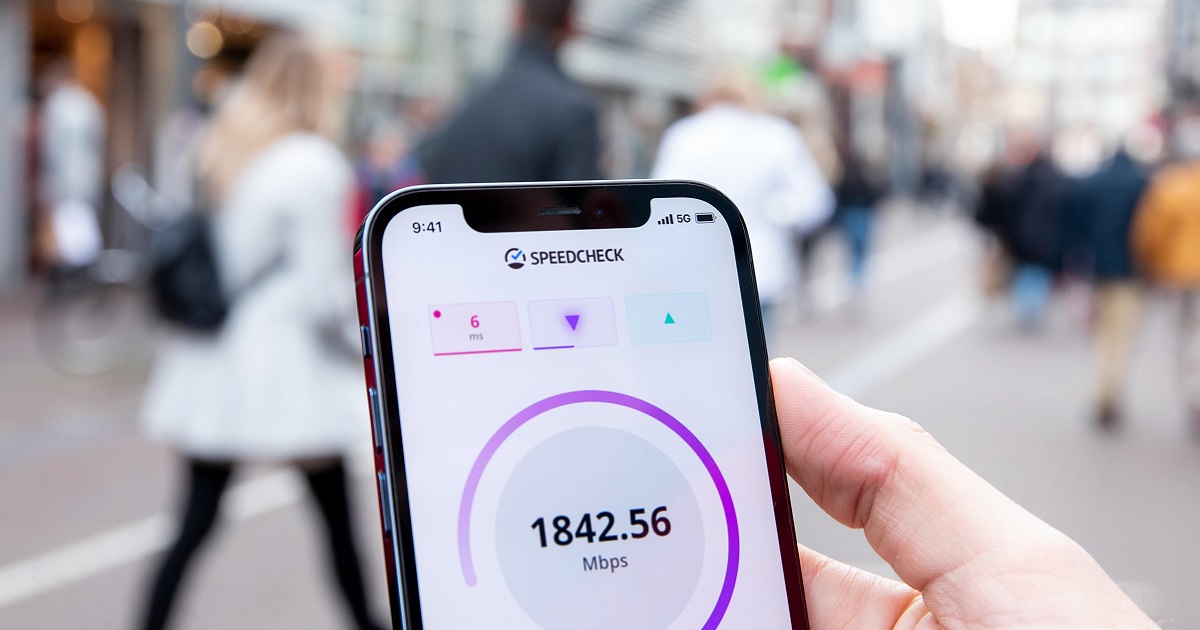Life in the Fast Lane: 5G going on 6G
Can you imagine an even more connected world? Those in the know say that we’re in for a huge leap with 6G. Reyana Nacerodien reports. This article was first published in In Focus issue 8 magazine.
5G has only just been introduced in various parts of the globe and already the hype around 6G has begun. It’s a foregone conclusion that 6G will further introduce several newly disruptive technologies. What can we expect as we accelerate from 5 to 6?
Thanks to 5G, industries are going digitally developing at a faster pace which has been a blessing amid COVID-19 challenges. Applications developed on the basis of 5G, AI, cloud and big data have played a significant role during the outbreak. Geographic disparities do exist as reflected in the speed of 5G rollout even in markets where coverage is the most advanced such as the United States, South Korea and China. While 5G is rolling out faster than 4G did, some markets will need to play catch up as 6G is already all the rage.
The 6G Hype
6G has been discussed in various forums for some time, most notably at the 6G Wireless Summit which is already in its third year of existence. The platform offers the 6G community experts’ views in order to generate wide interest and discussion on visions, challenges and requirements for 6G at a time when 5G is quite literally still kicking in.
Wireless Communications Laboratory, or WiLab for short, is the Italian laboratory of wireless communications and it’s directed by Professor Roberto Verdone of the University of Bologna. Founded in January 2020 under the auspices of the Italian Inter-University Consortium for Telecommunications (CNIT), WiLab boasts about 50 researchers and professors of different Italian universities. Among its competencies, WiLab counts on deep knowledge of people tracing technologies using mobile radio networks.
Roberto says that there are two reasons why the hype of 6G is already dominating discussions. The first reason lies in the normal process of development of a new Generation of mobile radio networks. The five years before its deployment are dedicated to standardisation. Before this phase starts, in the previous five years research is conducted by the major stakeholder, to gather competence and patents on the new technologies, candidate for inclusion in the standard. With the advent of 6G expected for 2030, 3rd Generation Partnership Project (3GPP) will initiate standardisation efforts at the end of 2024 and the beginning of 2025. So, the research phase has already started.
The second reason is more related, specifically, to 6G. During the phase of standardisation of 5G, relevant associations of main global industry stakeholders have identified the needs of sectors like manufacturing and automotive applications. While 5G can address some of them, it’s already clear that many applications such as fully autonomous cars and digital twins in industry plants have requirements that cannot be met by 5G. Digital Twins, as the name suggests, are the digital or software equivalent to real-world objects such as industry machines. These real-time software options evolve with time exactly as the true real-world objects would. They require a precise model of the physical object and real-time information captured from the physical object through sensors.
The final goal of a digital twin is to act as a tool to implement predictive maintenance, because the model, synchronised to the object, allows to predict if failures are going to happen – a solution for which 5G falls short. So, while 5G implementation is underway, limitations and shortcomings have already been identified. In October 2020, WiLab established a decennial agreement with Huawei, to pursue fundamental research in the field of the intelligent Internet of Things (IoT) for 6G. Looking to the future, Roberto says, ‘As much as 5G has opened doors in the technological space and the rollout is in play, gaps are already being identified. So, we need a new Generation to satisfy these needs.’ Various platforms and groups have responded to this call.
What can we expect with the Advent of 6G?
In Finland, the 6G Flagship is a research venture with firm goals for 2030 driving its progress. The Finnish 6G Flagship is a vigorous research and co-creation ecosystem for 5G adoption and 6G innovation led by the University of Oulu and appointed by the Academy of Finland, a governmental funding agency for high-quality scientific research. The team at the research program concur with the sentiments of WiLab.
‘The 6G Flagship envisions a future society towards 2030, which is data-driven and enabled by near instant, unlimited wireless connectivity,’ explains Jukka Riekki, a strategic research area leader in distributed computing at 6G Flagship. ‘Our 6G experts seek major scientific breakthroughs in four interrelated strategic research areas which are wireless connectivity, device and circuit technologies, distributed intelligent computing, novel vertical applications and services.’
6G Flagship’s experts foresee the main future uses of 6G in specific verticals including health, industry 4.0, automotive and energy, which are already present in the ongoing 5G rollout. Technology, sustainability and business are recurring themes in the research conducted and platforms presented. In this regard, an even more holistic and integrated approach is taken to the future possibilities of technological development with 6G.
‘The telecommunication community is usually good at technology development, but the inclusion of sustainability at the level discussed in the 6G Flagship white papers produced and presented is something totally new and goes beyond the approach in the prior generations of networks,’ notes Dr Marja Matinmikko-Blue, a research coordinator of 6G Flagship. In her research work, Marja takes an interdisciplinary approach bringing together technical, business and regulatory domains of wireless communications, and focuses especially on spectrum management and sustainable development of 6G. The business environment will undergo a drastic change when digitalisation is gradually introduced to all aspects of society.
‘Looking at different continuums, for instance humans-machines, the needs of the different types of users must be addressed, with the goal of sustainability at all levels,’ Marja says. ‘The role of ICT in meeting SDGs is critical. It’s not enough to treat 6G development and UN SDGs separately. The UN SDG framework will also need to evolve with the technology development.’ Thought leaders like Marja concur that it’s these possibilities that require more work to be done right now. ‘Technology-centric versus a business focused continuum, on the other hand, is a good reminder for us telecom experts. The potential we see for wireless in verticals is only realised when the vertical businesses can harness the benefits.’
The young people of today will be the developers and users of the new 6G systems in the next decade and we must invest in offering them a solid knowledge base with tools to achieve the best possible outcomes that transform societies. From his vantage point with the work that WiLab are engaged in, Roberto too sees two major trends unfolding.
‘On the one hand, the industry requires a system offering performance, trust and reliability larger than 5G. On the other, the evolution from 5G towards 6G will revolutionise the way humans will use mobile technologies; the advent of new human-device interfaces, for example, based on 3D holograms, and tactile technologies will make much deeper the sense of communication with other people. We’ll not only rely on visual or audio perception. All senses will be involved, to make it possible to live a full experience when communicating remotely,’ says Roberto. He agrees that progress in all fields and sectors is a given, but hopes for a human-centric society. ‘Something that we need to tackle and we still do not address enough is a greener way to achieve progress and wellbeing.’
Preparing for the Future
In the meantime, exciting projects are underway to further generation networks. The Minimisation of Drive Tests (MDT) project at WiLab, for example sees the scientific collaboration between Telecom Italia, Italy’s telecommunications giant, better known as TIM and WiLab. The partnership aims at the production of scientific material and joint research related to the issues of network optimisation and development of Self-Organising-Networks (SON) algorithms for future generation networks 5G and Beyond 5G (B5G), starting from big data MDT analysis.
According to WiLab, the spatial and temporal granularity offered by these data can in fact be exploited as an excellent source of statistical channel state information and lends itself to an analysis by machine learning techniques. The work that Wilab will carry out with TIM on this data will focus on the study and application of artificial intelligence techniques in order to propose new methodologies of radio resource management according to the three paradigms of SON networks which are self-configuration, self-optimisation and self-healing. Network optimisation is one of the potential outcomes.
Further, WiLab’s work with holographic radio using intelligent surfaces aims to study the benefits of intelligent surfaces made of meta-materials in the optimisation of wireless communication and localisation systems. The introduction of intelligent surfaces changes the design paradigm of wireless systems from systems that adapt to the environment, to systems that are jointly optimised with the environment. One of the applications of this technology is certainly in the Industrial IoT sector, where thousands of radio sensors are connected in harsh environments characterised by metallic obstacles and people on the move, with the additional advantage in mitigating electromagnetic pollution.
The current experimental environment and expert service at work are intended to deepen the pioneering research on next generation wireless systems. Already, there are companies making use of the diverse experimental environment and knowledge being generated in the early stages of 6G research. More developments will undoubtedly, rapidly unfold with the potential for even more visibility, application, new opportunities and future markets offered by emerging technologies.
Main photo by Frederik Lipfert on Unsplash.


